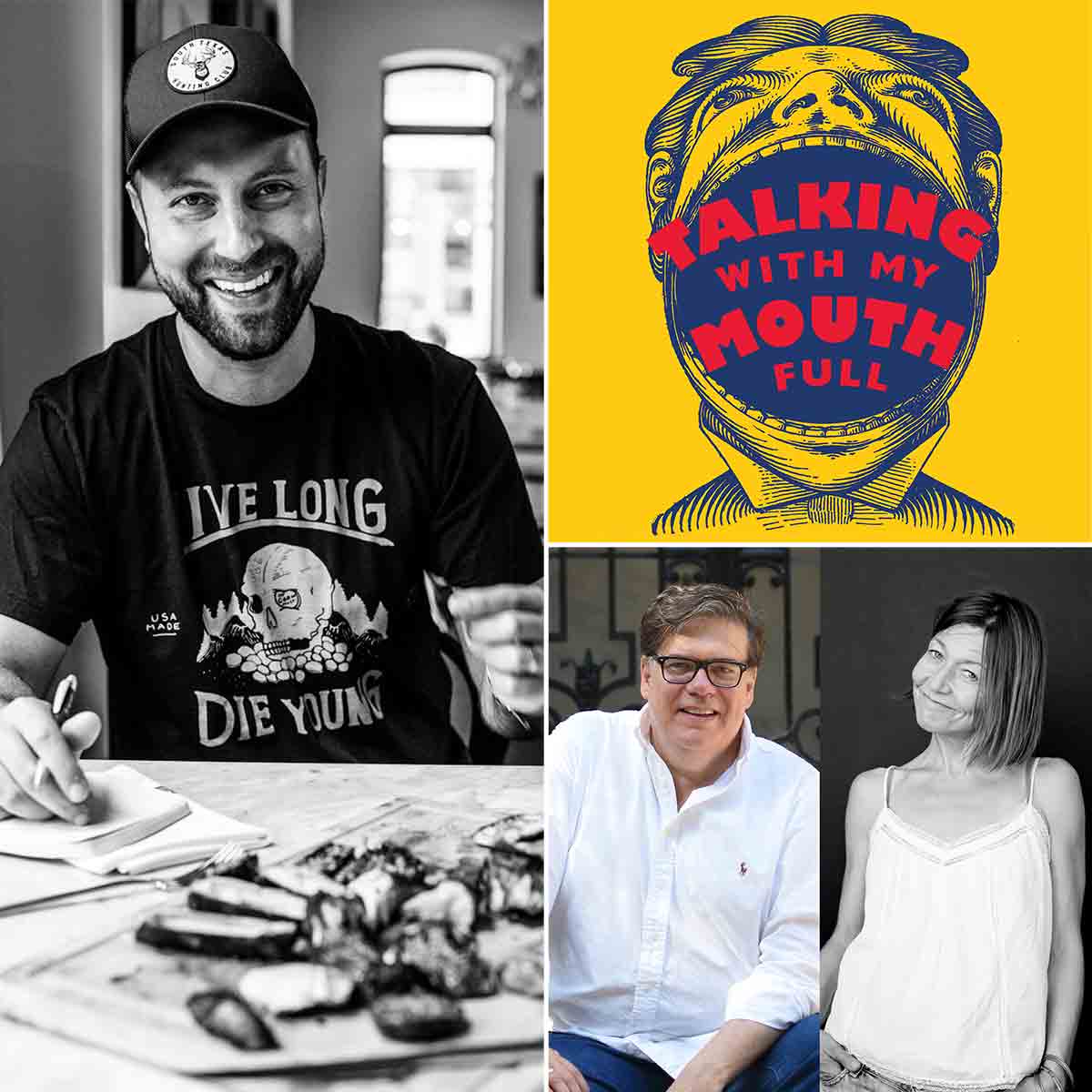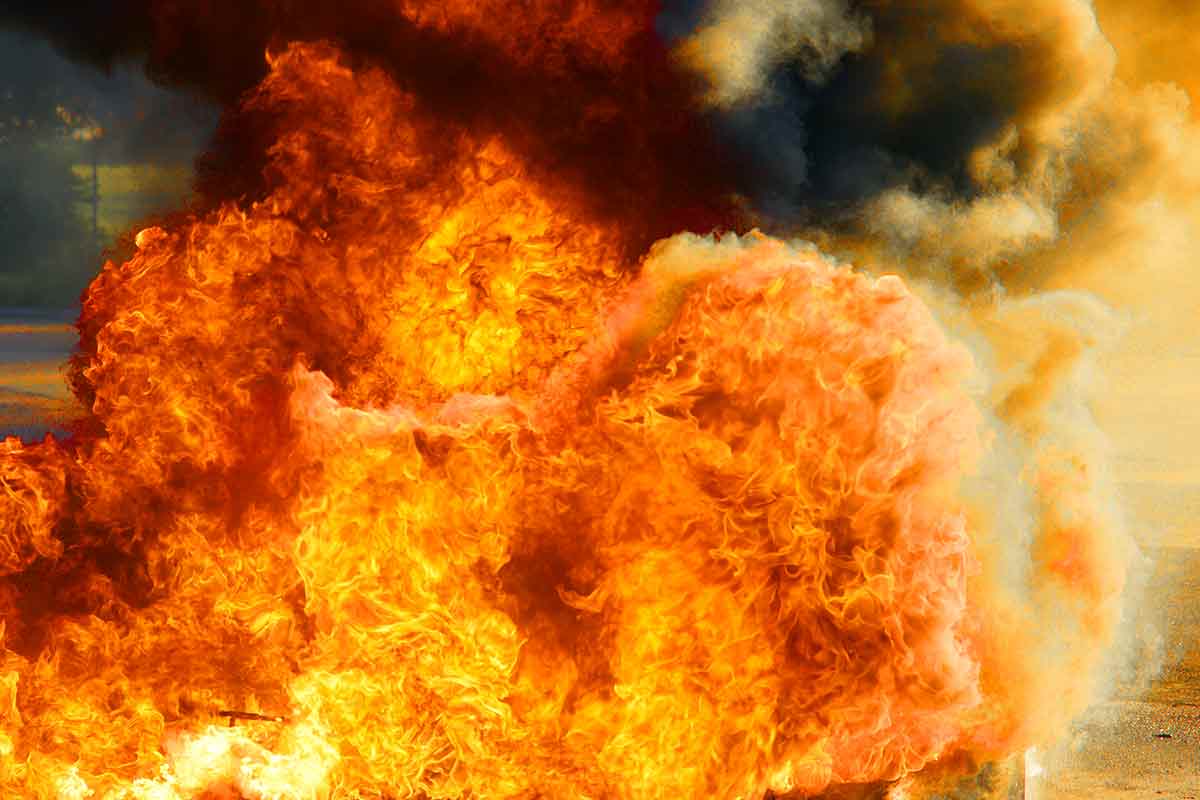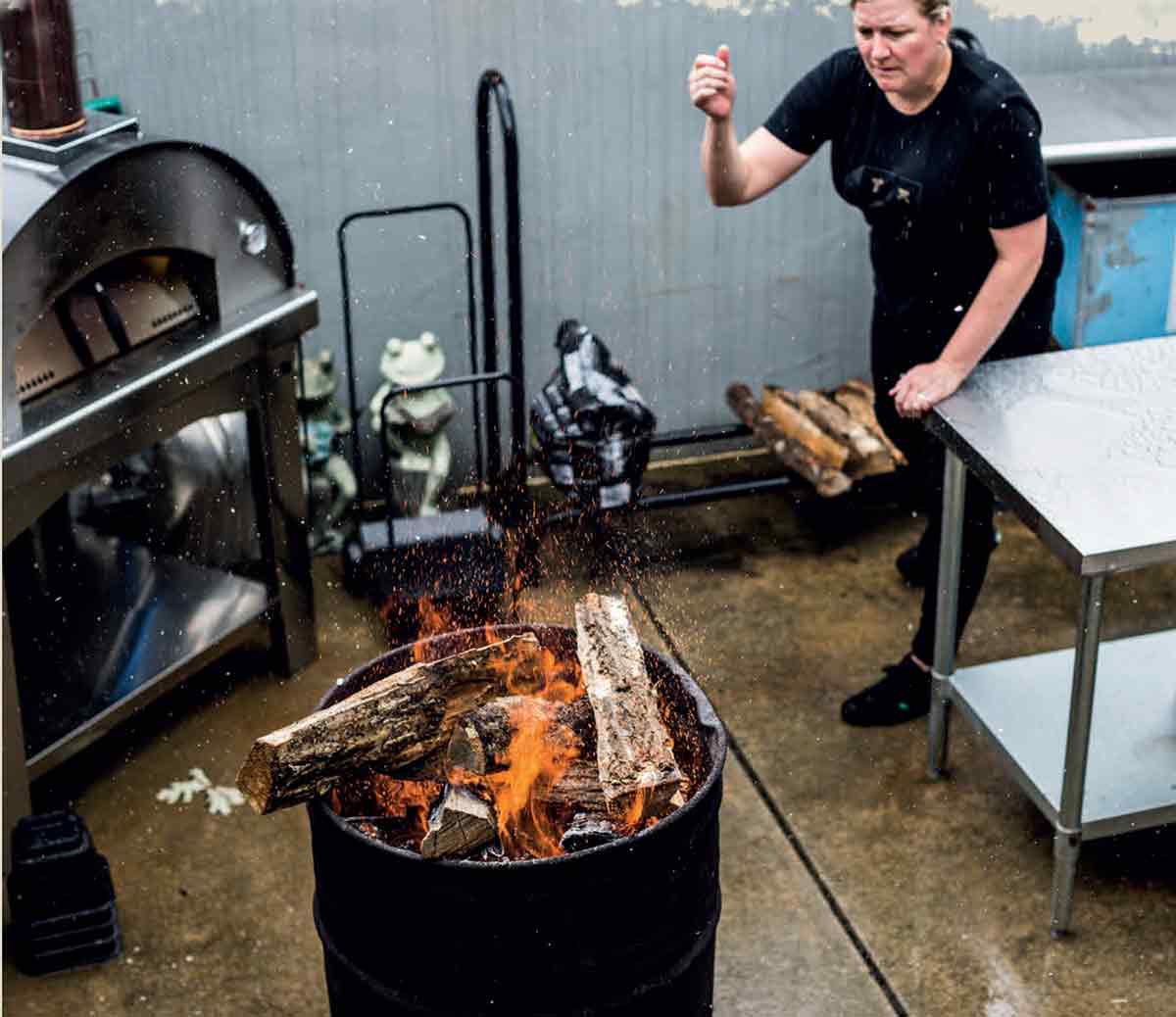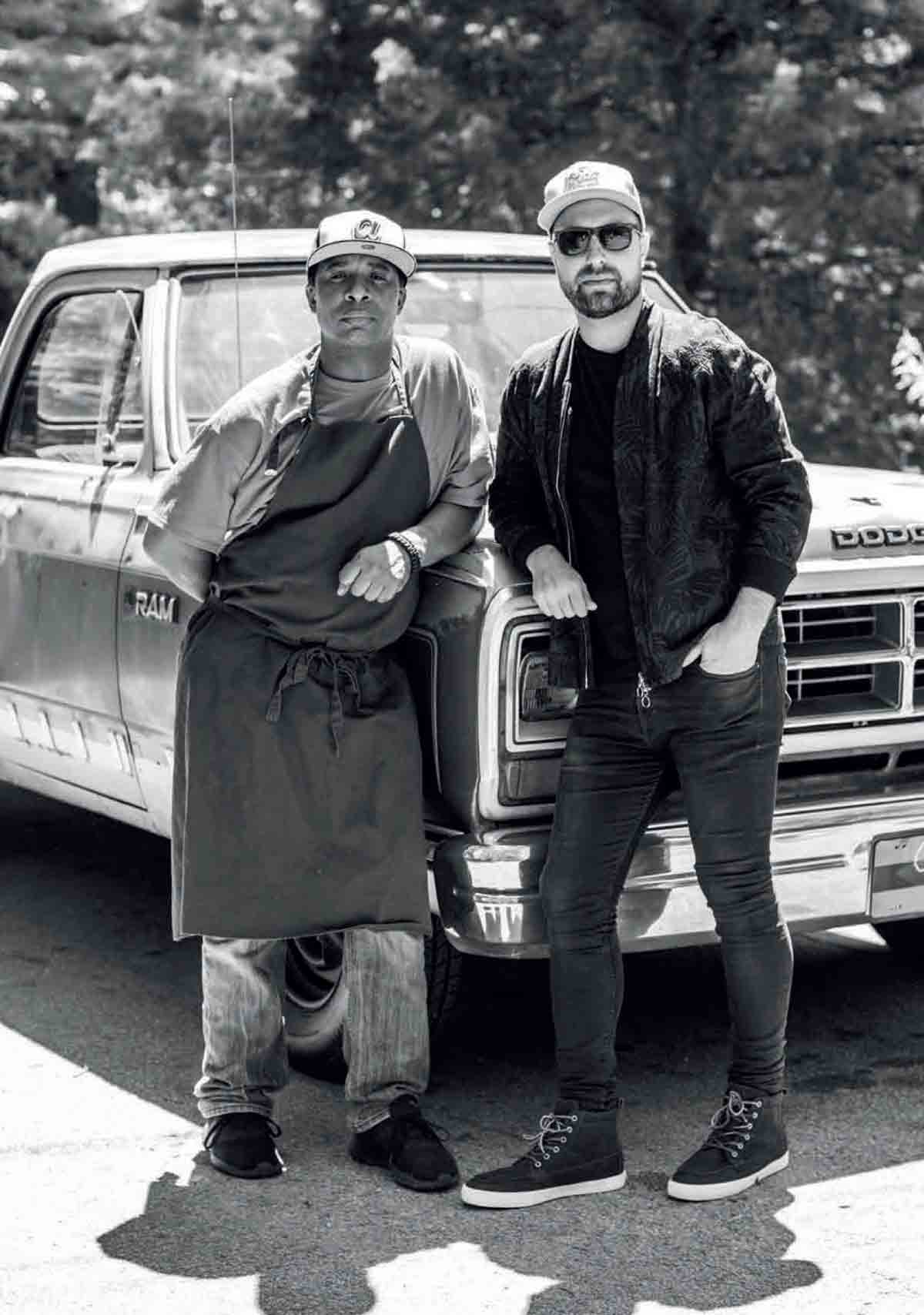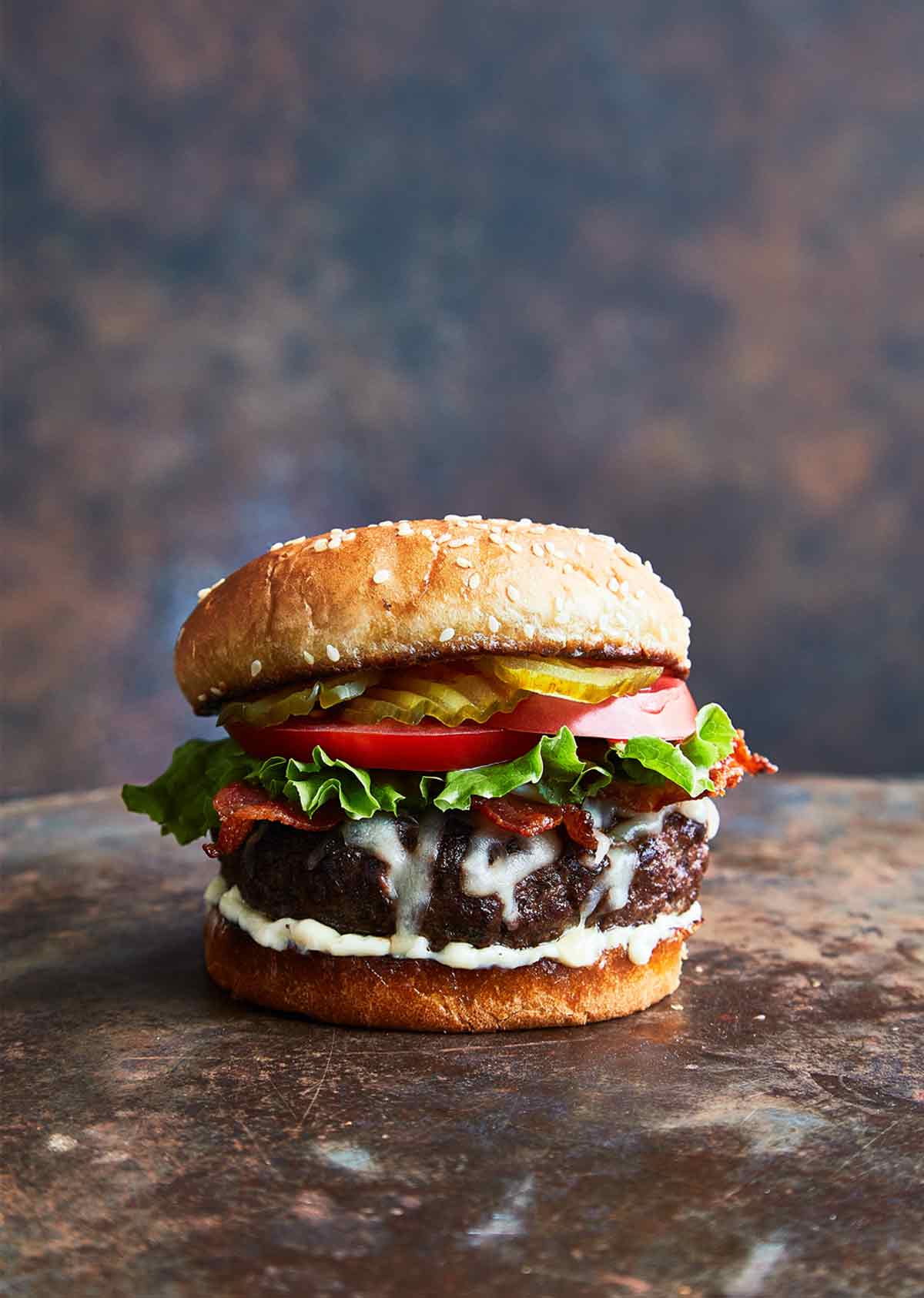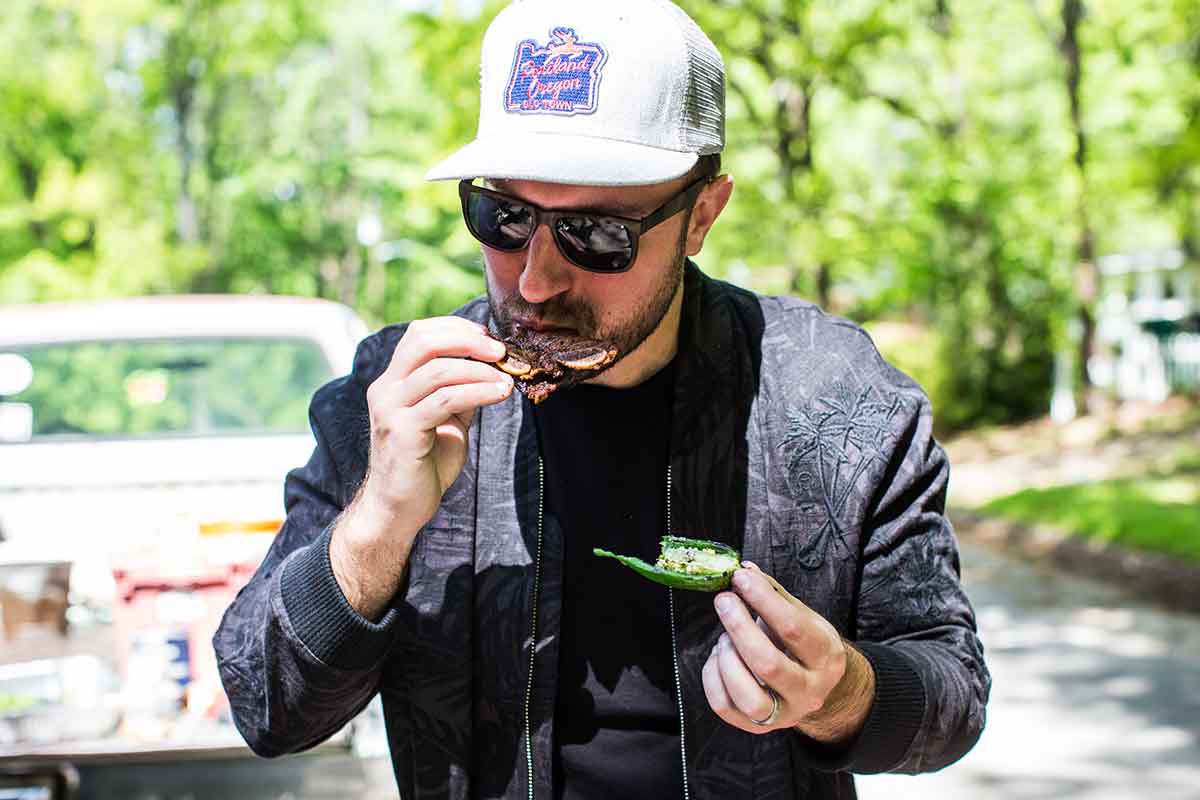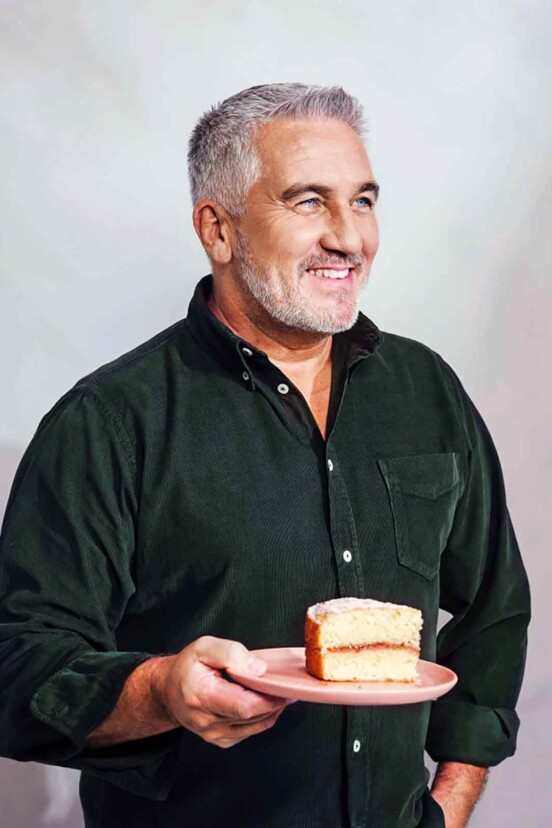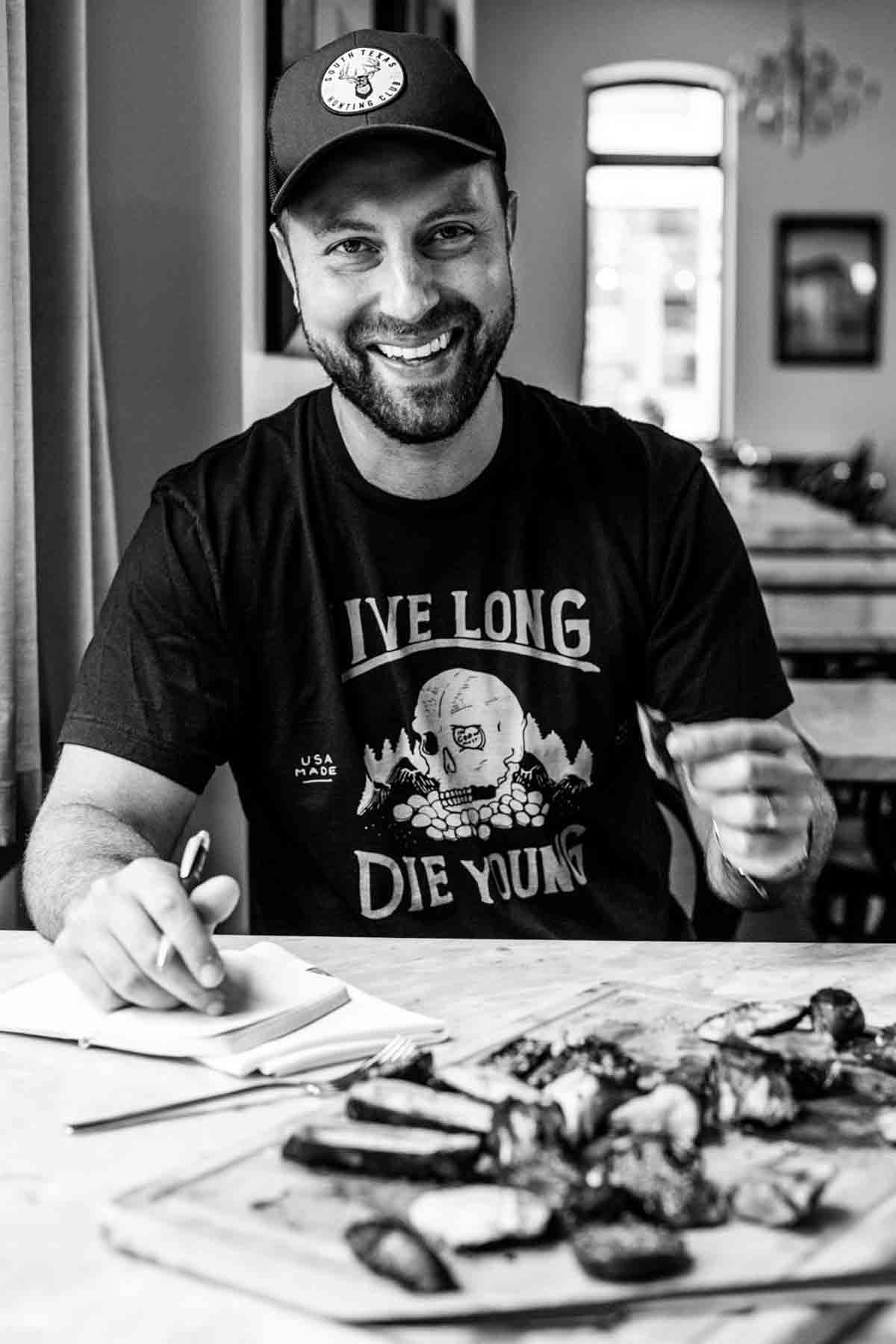
SUBSCRIBE ON Apple | Spotify | Sticher | Amazon | Google | iHeart | TuneIn
☞ If you like what you hear and want to help support us, even $1 will help! Thank you.
Have a question, query, or quagmire you’d like Renee and David to answer? Click that red button to the right, or click on this link to leave us a recorded message. Press and talk away and maybe you’ll be featured on the show!
Grilling. Many of us do it, some of us want to learn how to do it, and pretty much all of us could stand to learn how to approach it with more ease. Without any more delay—because, after all, summer always seems far too short—we welcome you to our podcast with Nashville chef Matt Moore, who has not only spent a disproportionate amount of his life standing at the grill but eating pretty much anything cooked on the grill while traveling around the country and interviewing chefs and outdoor cooking gurus about their techniques, histories, and stories. Sit down, have a listen, maybe take a few notes, and then off to the grill.
[renee-signature]
Chat with us

Transcript
Renee: David?
David: Mm-hmm.
Renee: Who tends to man the grill at your house? You or The One?
David: Oh, very interesting choice of words there, Renee! “Man the grill.” I think that’s rather instructive and I think that’s actually kind of the point. Neither of us “man” the grill and neither of us don’t man the grill. We have this love/hate relationship with our grill. We don’t fully feel we know how to grill perfectly, but we feel that we don’t want to be inside all of the summer. So we “muddle” our way through the grill. Maybe that’s the best way, not man, but muddle.
Voice Of Conscience: What could possibly go wrong?
David: You love steak. I know the big, bloody rare, barely moving steaks. Are you a big griller?
Hungry Guest: Get back here. It’s dinner time.
Renee: You know, you have to remember, I spent 20 years in tiny apartments on the East coast. So I had all this pent up grilling need in me when I moved out to Phoenix. I did actually try grilling once on my fire escape in Washington, DC, and found out why there is a fire ordinance against doing that six feet from the building.
David: Please tell me you weren’t on the seventh floor and people on the third floor discovered that you were grilling, please! It didn’t tip over, did it?
Renee: I handled it. I’ll just leave it at that. I handled it.
David: A shower of dinner and sparks and hot coals.
Renee: Anyways, so since moving back home to Phoenix, I have begun to get my grilling legs underneath me. But like you, I’ve muddled through a lot, right? Steaks, I’m getting there. Chicken, I’m pretty good with. Fish, I’m working on.
David: Oh boy, yeah.
Renee: Yeah.
David: It’s hard. What about you, Adam? Are you a big griller, smoker kind of man?
Adam: Well, I’m not a smoker. I wish. I love smoked meats. I do love to grill. But I mean big griller? Probably not. But I’ll eat anything grilled. Serve it up.
David: Yeah.
Renee: Nice.
David: Do you have any big challenges when it comes to man-versus-fire for you?
Adam: Yeah, I guess probably what I’d say is really the same as Renee, it’s fish. It’s always been kind of a big question mark for me. How long to cook it? And make it so it’s not all burnt and nasty on the outside.
David: Yeah, that’s true. And another challenge for me is really trying to find the right wardrobe for grilling. What would make me look best for grilling? So that’s always…we plan that months in advance before the whole grilling season starts.
Renee: Anyways, it’s a good thing we have a guest here. We’re not going to talk about fashion at the grill, but we are going to talk about challenges at the grill.
David: I think fashion is a very big challenge for a lot of people, Renee.
Renee: Hey, I love my Vogue and I love my heels, but there’s a time and a place for everything.
David: I’m David Leite, the founder of the website, Leite’s Culinaria.
Renee: And I’m Renee Schettler, the site’s editor in chief.
David: And this is the non-fashion version of Talking With My Mouth Full. And it’s a good thing for Adam and me and also Renee, when it comes to fish for you, that we have our very own Saint John of Arc when it comes to the grill here to save us from the mortal sin of ruining a great piece of meat or protein with fire. Matt Moore is a Nashville musician, a chef, a pilot, an entrepreneur, a Southern gentleman, and author of four cookbooks. His latest being—I love this title—Serial Griller. Welcome to the show, Matt.
View this post on Instagram
Renee: Matt, welcome.
Matt: Hey guys, thanks so much for having me.
Renee: We’re glad you’re here. For your most recent book, Matt, you traveled across the 12 states that make up the barbecue belt to interview various chefs. Can you tell us about the sort of people you chose to seek out so you could learn their secrets?
What are the different grilling influences you cover in the book?
Matt: Yeah. For me, it’s always kind of been a bit of an inexact science. So as you mentioned in the last book is actually where we traveled the barbecue belt. It was called The South’s Best Butts. And I always tell people that it’s not a calendar. We did the 12 states that make up the barbecue belt. But for Serial Griller, we actually kind of expanded the horizon. Being a Southerner, obviously grilling is something that permeates really every society around the world. And I’m a big believer in diversity and the fact that we could solve a lot of problems if everybody could sit across each other from a dinner table. And the cool thing is that in nearly every culture and cuisine across the world, cooking over a live fire is something that everybody practices. So it allowed me to kind of broaden the map. We actually ended up traveling about 10,000 miles for Serial Griller.
David: Wow.
Matt: As I like to say, hunting down some of the best grill masters across the country. So some are well known, like Michael Solomonov up at Zahav in Philadelphia and Ashley Christensen in Raleigh from Death & Taxes, who have been fortunate to win the last two years of James Beard Outstanding Chef. But at the same time, we also wanted to pay homage to experts like Meathead out of Chicago, up-and-comers like Marjie’s Grill in New Orleans. And then just a big cast of characters like Jerry Baird out of Texas or Cadillac out of Atlanta. So certainly a journey to try to capture as much as we could on the road.
David: In the book, there’s this incredible influence from the Middle East. And you have souvlaki in there—octopus souvlaki. Talk about some of those influences that are influencing your work and what you pursued when you were looking for people to cover in the book.
Matt: Yeah, for me, as I mentioned, the fact that we’re so blessed to live in a country where everybody comes from somewhere else, we bring our cultures and our traditions here, and our food is very much celebrated. So for me and my family, my mom, my grandparents are from Syria and Lebanon. So we grew up with a lot of that Middle Eastern influence.
Renee: Interesting.
Matt: And I’ve always been interested in that flavor of a lot of garlic, a lot of vinegar, a lot of citrus, olive oils, and charcoal. And so what you mentioned, David, the souvlaki, we picked that up at a place called Greko, which is just about a mile from my house here in Nashville. And I live in East Nashville, a really diverse part of town. And that restaurant, particularly, we grew up kind of with a kind of Chicago-style Euro places here, where they’re using that very cheap kind of frozen cone where people go in and it’s more about being fed a hearty meal, very cheaply.
Matt: Whereas these guys came from Athens, Greece, and they wanted to pick up on Athenian-style Greek food. So they’re really cooking from scratch and producing all of this over a large charcoal fire. And of course you pick up, from Zahav, with Michael Solomonov, he’s got the influence from Israeli food. It’s obviously, I think, some of the most exciting food that we find in the country. And he is, as we’ve already mentioned, one of the best chefs here in America and his restaurant is very difficult to get a table at. But I got a table because American Airlines kept canceling my flights through Philly. So I would just go to the bar by myself and eat. And that’s truly how we struck up a friendship. It’s kind of a brotherhood of, I guess, coming from the Middle East and sharing cuisines. And I talked to him about how he made his kibbeh nayyeh, which I told him reminded me of my grandmother. And I think we became fast friends.
David: Cool. Very cool.
Renee: Got to do it. So narrowing the world of grilling down to Southern grilling, Matt, I’ve heard you say that it basically comes down to three components. It’s about the pork, it’s about the low and slow, and it’s about the wood and the smoke. Can you talk us briefly through each of those components?
What’s the difference between barbecuing and grilling?
Matt: Yeah. And I think that we’d probably revisit, again, probably the idea of more of barbecue versus grilling. So as a Southerner, we know we really define the two as disparate subjects, right? So barbecue to me is something that is primarily very low, very slow. And Southern barbecue, we really allocate that to pork. Obviously, as you make your way westward towards Texas and Oklahoma, you begin to pick up more influences when it comes to beef. So the idea of barbecue, true Southern barbecue, most Southerners in the deep South will tell you it’s got to be pork, it’s got to be cooked indirectly for long periods of time. And that’s kind of the last book was where we focused on the pork shoulder, or what we call the pork butt, of really taking a very cheap cut of meat and using time and temperature and wood to equal results.
View this post on Instagram
Matt: And in the new book, Serial Griller, we really wanted to shift that narrative to say, how do we make everything great over a live fire and cook everything very hot and fast. Scientifically, there’s actually a method for that. It’s known as the Maillard reaction, where all good things happen above 300 degrees. And in the last book, I had a great pit master told me that nothing good in barbecue happens above 300 degrees, whereas everything great in grilling happens above that temperature. Because you get that natural, brown-food-is-good-food reaction of the natural enzymes and sugars. So in Serial Griller, we’re really trying to set up a stage where, at every moment throughout the process, we’re allowing that Maillard reaction to occur so that we get that beautiful char, that aroma, that umami flavor that’s so significant when it comes to grilling. So two disparate subjects, in my opinion, that a lot of people probably confuse, especially my wife, who’s from Wisconsin who invited me to a barbecue one time at her home outside of Milwaukee. And I showed up expecting pulled pork sandwiches and baked beans and coleslaw. And there was bratwurst and Miller Lite and cheese plates. Which was great, but it was not barbecue.
David: Yeah. Exactly. Interesting.
Renee: Very good distinction.
David: So when it comes to grilling, what are the three foods that people really gravitate to mostly?
The classic grilled burger improved
Matt: Yeah. I mean, Americans have their classics. So the burger is just a classic grilled item. I think one of the most popular techniques that has really caught fire, I guess, if we’re going to play a pun on words here, in the book, we actually went and visited a place outside of Athens, Georgia, which is my alma mater—so Go Dawgs—called The Grill, in Athens, Georgia. And they, in fact, do not cook over a live fire. They cook on a flat top, a griddle. And I did that on purpose because I knew I would catch some critical folks that might say, “Hey, it’s not true grilling if it’s not over a fire.” But I actually believe you cook the best burger on a flat top. So the way that we overcome that on a standard grill is just utilizing a cast iron pan. Whether you have a gas grill, if you have a charcoal grill, even if you don’t have a grill, I know a lot of folks have been stuck at home and not been able to get outside or just their Homeowners Associations don’t allow it, you can still get a great sear on the outside of the burger over the stovetop and finish it off in a warmed oven.
[essay-video]
Matt: So it allows it to get a beautiful sear, as I mentioned earlier, and it also allows it to cook up in its own juices. And I think that’s one of those classics that a lot of people can solve the hockey puck syndrome or the flare-ups that they get from a traditional gas or charcoal grill simply by putting a $20 lodge cast iron skillet right on top of the grates. I think at the same time, we hear a lot about steaks. That’s just quintessential grilled American food. I spent some time with Meathead out of Chicago.
David: You got to love Meathead.
Matt: Oh man, he is honestly one of my favorite people ever. And I have so much respect for him and we argue a lot, but he always wins. But at the end of the day, when you taste his food, you know why. So he really was a pioneer of kind of the reverse sear, as he calls it, the redneck sous-vide, of indirect cooking, low and slow, on a smoker or a charcoal grill or even a gas grill. And then of course letting that Maillard reaction happen. So steaks, we give you a lot of different recipes when it comes to that.
What do you grill besides, you know, meat?
Matt: But I think what I’m most proud of is, beyond those classics, we spend a lot of time on a lot of alternatives. So my kids, I’ve got a five-year-old and a three-year-old, and they would not eat a Brussels sprout that I would roast in the oven, but they’ll eat one if I pull it off of a grill.
Renee: Interesting.
Matt: So a lot of grilled vegetables, a lot of grilled salads, a lot of grilled fruits and desserts. So the idea behind Serial Griller, besides being just a funny title that I think is eye-catching and something you remember, is the idea that no matter the course, no matter the meal, we can make things better over fire. And then that’s really something that parlays into a lot of different cuisines and dietary lifestyles, whether you’re a vegetarian or vegan, or if you’re a pure burger and steak and chicken person, there’s a lot to pull from when it comes to accessing the power of the grill, if you will.
David: Well, that’s one of the things that I was really impressed about with the book, is that you go from nibbles to apps, to main courses, sides, and also desserts. And of course, nobody thinks desserts. So whenever we grill, by the way, and I said this earlier to Adam and to Renee, I am not a very good griller. I think I am constitutionally unable to grill well. I think I’m just missing a gene, or some people may say enough testosterone, to be able to really work a grill properly. But whenever we do that, we always bake dessert in the house and then bring it out. Now, talk to us a bit about using the grill as an oven, because I’ve seen some of the great stuff that you do. And I think people have a disconnect in their head. Men will grill, women will go in and bake something. And I don’t think it has to be that way.
Matt: No, I mean, first things first, just pause one second. You’re ready. This is what you’re missing. David. You ready?
David: Yeah.
Matt: Here we go. [Snap of metal on metal.] Did you hear that?
David: Yeah, I certainly did. What is that? I don’t know.
Matt: That was a pop of a cold beverage.
David: Okay, that’s all I’m missing is a pop of a cold beverage and I’ll be a great griller.
Renee: You need to relax a little, David.
Matt: You know, David, for me, my mom—mama, as I call her, being a Southern boy—she is the one that taught me really everything about cooking. But my mom can work a grill just as well as my father can as well.
David: That’s great.
Matt: And I think in all my books, including barbecue and grilling, it’s really important for me to showcase an equal split because I don’t think it’s primarily a masculine thing to grill. In fact, I’ve seen a lot of fantastic women pull off some amazing feats that men would be lucky to pull off. And in fact, the entire team that shot the photography and did the food styling was all a female team and that was done on purpose.
David: Yes, we know many of them. Hélène Dujardin, one of our colleagues.
What are the different types of heat in grilling?
Matt: Hélène is awesome. Absolutely. So I think when you talk about baking, we spent some time in the book talking, and this is a great topic that Meathead and I actually do agree on, on the different forms of heat. So you have radiant heat, which is often referred to as direct grilling. You have indirect heat, which is convection-style grilling. And then you also have conductive heat, which is coming off of just the metal or the grates. And so I think I go through an analogy, if I was hanging out in Savannah on a hot summer day and I was standing right under the sun, that’s an idea of radiant heat or direct grilling. So to cool off I’ll move to the shade. And if you’ve ever been in Savannah during the summer, it provides a little bit of relief from that direct sun that’s beaming down on you.
Matt: But you’re in the shade and you’re getting that convective activity also with some humidity that we try to avoid in grilling. But it’s still hot. And so that’s the idea of kind of baking. And if I were to go back out and sit on a black metal bench that was sitting there in one of the corners, if you’re imagining Forrest Gump right now, then I would most likely burn a hole through my pants because that’s that conductive heat that you’re picking up just from the grill grates. So, in baking on a grill, the idea is that we’re using indirect heat and we’re closing the grill because we want to trap the heat in the exact same way that you would an oven. And then when we talk more direct heat, that’s more kind of like cooking directly over your stovetop. And then the conductive heat is the whole idea of preheating your pans on the stovetop so that you allow that metal or cast iron to do the work that’s necessary when it comes to picking up that char.
Renee: I love that. You keep the heat in the grill and not in the kitchen by firing up the oven.
Matt: Absolutely.
David: What are some of your favorite desserts—grilling desserts?
Matt: I actually think probably one of the most underrated desserts are fruits.
David: I agree.
Matt: With all the natural sugar and fruit, you allow that Maillard reaction to occur. So we have quite a bit. We have figs, we have watermelon, we have peaches, apples, pineapple.
Renee: Wait, you put watermelon on the grill?
Matt: Oh, it’s unbelievable. Yes. So just a really hot heat is what it needs and direct heat and that conductive heat as well. So watermelon on the grill is a fantastic dessert as we do, kind of finishing it with some pistachio and some crystallized ginger and orange zest and a little bit of Greek yogurt. It’s just a showstopper. It’s really fresh.
David: Absolutely brilliant.
Matt: Yeah. You could still do it as a salad, right? So you have a grilled watermelon where the idea is not to grill it too long, just to get that char and that reaction to where you kind of get a little bit of warmth that’s contrasted with the coolness. I was just at some friends’ today at the pool. And we did literally, I put some watermelon on the grill with some really nice feta cheese and some fresh mint from the garden and a really nice drizzle of aged balsamic vinegar. And it’s just taking kind of a salad that people are, I think, more common, to kind of a watermelon salty feta salad. But you put it on the grill and it just picks up that smoke and char. It’s a no brainer. And then, again, talking about the South, peach cobbler is my nemesis. I love it, but I can’t eat it every day. So the way I pull that off is I just put some peaches on the grill, maybe a sprinkle of brown sugar or honey, and serve that with vanilla ice cream or a vanilla Greek yogurt. That’s just a fantastic finish to a great meal.
David: Sounds superb to me. That’s one of the things I do do well, I think on the grill, is I do use the cast iron skillet a lot.
Matt: Sure.
David: For vegetables and for fruit, I will use that. I’m better with that than actually right on the grill.
Renee: Matt, I got to ask. When you’re at other people’s backyard barbecues, like you mentioned earlier today, are you the one always assigned to the grill? Do you ever get a break?
Matt: I’m glad my wife’s not here because she would tell you that I’m always put in charge. We have a great community here in Nashville and most of the time, if something’s going on, I’ll usually get pulled into the cooking where she’s like, “That means you’re not hanging out with me. You’re just cooking.” But at the same time, we live in a pretty big foodie community. So I actually try to step back and I always tell people “I’m not a food critic,” right? I have such this cool job that I get to canvas the country, write cookbooks, tell my stories. And I’ve really never met a meal that I didn’t like. I mean, I’m just somebody that kind of likes everything. So I’m not there to kind of judge things. I think it’s just cool to learn from people and tell their stories.
Matt: And especially with the last two books, I’ve been responsible for sort of being the conductor. We fly my little small plane all around these places. And my hope is that you’re sitting in the right seat and the plane, hopefully not on a bumpy windy day, but you come along with us, you pick up the journey, you see these beautiful photos, you catch these kind of slice-of-life stories of these incredible people that are carrying on their own family and food traditions. And it’s just my job to kind of do them the justice and also be accountable for the responsibility to tell their stories and showcase their recipes. So I do often bow out if folks are wanting to cook, then by all means my goal is to get more people cooking and sharing food. So that’s a good thing.
Renee: Beautiful.
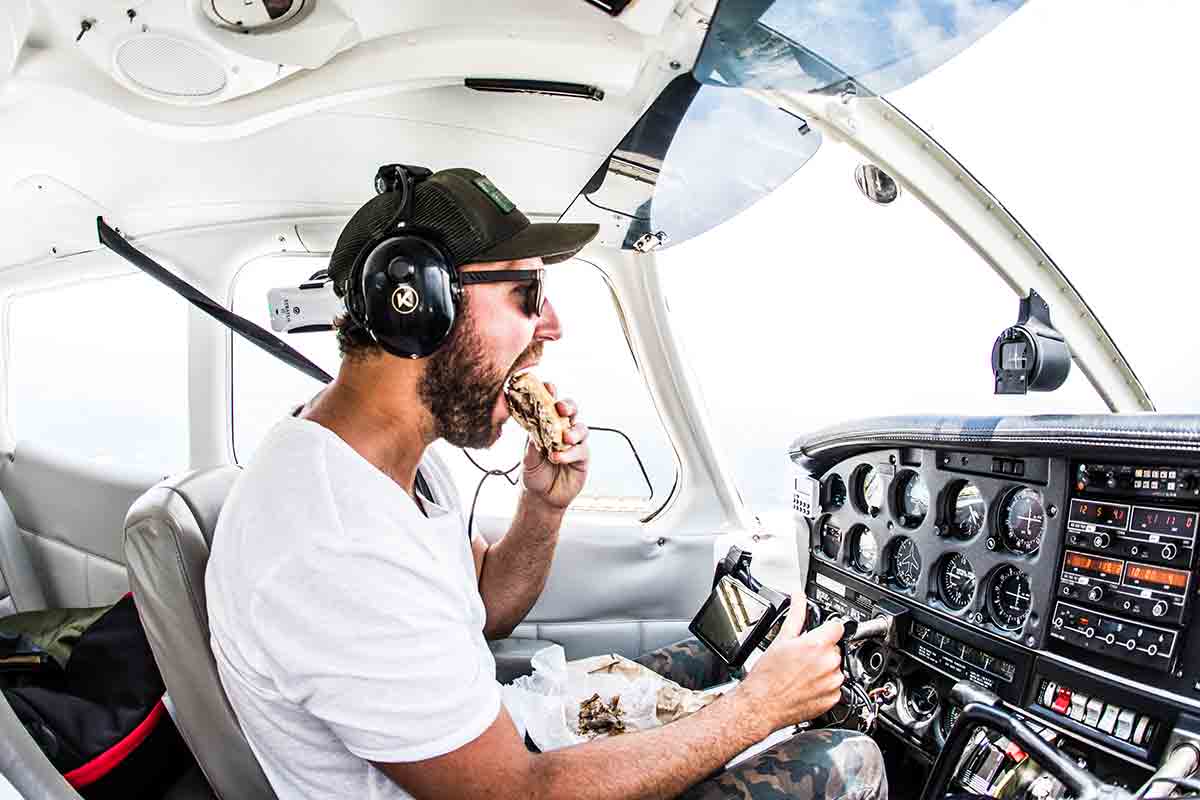
David: And you do, as you’ve mentioned, fly from place to place in your own plane. It’s a Piper, is that correct?
Is it true you’ve eaten pulled pork at 7,500 feet?!
Matt: Yeah, I’ve got a Piper Cherokee, a little PA-28. It’s nothing fancy. I call it a lawnmower in the sky, but it serves me well.
David: And there’s a great photograph of you, there, piloting this plane with a pulled pork sandwich, just about going into your mouth. Can you talk about what you were doing with that pulled pork sandwich and why it was important for you to be eating it up, I don’t know, 20,000 feet in the air, whatever you fly?
Matt: Well, I can’t get to 20,000, I’d need supplemental oxygen. But there’s actually, really, a funny story about that. My photographer, Andrea Behrends, who shot the last two books, she’s such an incredible photographer, and I basically have to convince her to hang out with me, even though I’m probably the weirdest person she’s ever met, for three months of her life. But on that particular day, she was like, “You want this photo of you eating a sandwich in a plane? This has nothing to do with a cookbook.” But I kind of told her that there’s a theme to all my books. They always have aviation-related photos. And I’ll never forget, because we were at about 7,500 feet, coming in from Memphis back into Nashville, and we were kind of staging this thing. Not necessarily the safest thing to do while flying the airplane.
David: Yes. Listeners do not try this at home. Please do not fly your plane while eating.
Matt: Because we don’t have autopilot and I’m like, “Just get one picture of me.” And right then, air traffic control came on and they said, “Cherokee, niner five, one, one kilo.” And essentially they made a call that there was an army helicopter below me, and they were unable to make radio contact with the helicopter because they were below, essentially you still utilize radio communications in aviation. And so if you’re below a certain altitude, it’s hard for them to reach. So was asking me to give air-to-air to the army. And this is right as I’m like chomping in.
Renee: You’re like, “Let me finish my barbecue sandwich.”
Matt: I was like, “Excuse me, ATC, can you come back?” And they’re like, “Can you make a radio call?” And like, normally you’re supposed to do everything correctly, but I was like, “Hold on a second.” So I have to ask again because I got to get the sandwich out of the way, I got to write down the code. So then I’m like, “Army…blah, blah, blah, blah…Cherokee…please contact…Memphis approach 122.97. So they contacted them and then we took the photo. But it was just like the worst timing ever. I think like flying in five years, I’ve never had to contact the army except for the time that I had a barbecue sandwich in my mouth.
David: In your mouth.
Renee: Makes a great story though.
Matt: Yeah, indeed.
David: It does. Not a lot of people have that.
Renee: Matt, so the most popular smoked meat recipe on our site by far, right? Smoked pork butt.
Matt: Sure.
Renee: Probably not a surprise to you. But can you talk us through what people need to know to make a pork butt that’s so spectacular you can literally slide the bone right out without any effort whatsoever, and the meat just falls apart?
David: Which we have seen you do on television. So we know you know how to do it.
How do you make the perfect pork butt?
Matt: Yeah. I mean, in the barbecue band of brothers, I often joke around that ribs are like the lead singer of the band. Everybody loves them, but at the same time, they’re quite finicky, they’re kind of flaky. I think lately the brisket has kind of been like the lead guitarist. It’s captured more attention, they’re trying to steal the spotlight. But I always say that the pork butt, which is the pork shoulder—there’s a bit of a misnomer there—is kind of like the drummer. They keep everybody in time. It’s super humble. And really the pork butt is probably the most versatile cut that you can find. So in my book, The South’s Best Butts, we traveled again, all 12 states of the barbecue belt, focusing on each pit master from the state and in how they represented the butt. It’s kind of like the old joke was “How is your butt?”
Matt: And one common denominator that you mentioned earlier, David, is that time and temperature will equal results, right? So you’ve got this massive eight- to 12-pound hunk of shoulder meat and the way people approach it is actually quite different. So Burn Company out of Tulsa, Oklahoma, will quarter it to create more surface area and they will actually kind of grill it, as I would say. They would cook it above 300 degrees and then they would wrap it in foil and then move it to indirect heat for four to six hours because they’ve kind of quartered it down. That’s probably the fastest that I ever saw a pork butt cooked as we were writing that book. Whereas you go to like Skip Steele, up at Bogart’s Smokehouse in St. Louis, and he’s literally cooking those butts at 200 degrees for 20 hours.
David: Yeah.
Matt: The same result is what you’re looking for, is for that bone to pull just super clean from the meat. I mean, literally where to it’s just nothing touches that bone. It comes out super evenly and there’s different ways to get there. But most would agree that no matter if you cut up the butt, if you cook it 275 degrees for 12 hours or 200 degrees for 20 hours, they all have different methods. But the idea is that you want to get that butt to an internal temperature of about 200 degrees and you want to do it low and slow because there’s a lot of fat and cartilage that needs to be broken down through the cooking process. So that was really a unique piece. And I also think that the diversity of what you can do with that meat, whether it’s barbecue spaghetti or like a Cuban banh mi or whatever the yield comes from that pork, is it really produces a rich array of recipes that’s worth celebrating.
David: And that’s what I love about your work and your cooking, is it blurs a lot of lines, talking about banh mi and other things you can do with this, where some pitmasters are just strictly what they do, which is terrific. I love the fact that there’s this ecumenical aspect to how you look at what you do. And you mentioned ribs. This is a question I had. Do you know B.E. Scott’s out in Tennessee?
Matt: I don’t actually. I was thinking you were going to say Rodney Scott at the first, but I’m not familiar with B.E.
David: Okay. It was Ricky Parker, who has passed. And I was there for about maybe 10 days, I worked with him. And there was whole hawg whole—I can’t say this, I’m from the North, so we say whole hawg—it was whole hog barbecue. And I remember, these things were the size of businessmen, and you flipped them onto the grill, and it was very low and slow for a very long time. And one of the things they did was they took the ribs and they would flip them out. And then when they flipped out completely clean, they knew that they were done.
Matt: Yep.
What’s your opinion on the proper “doneness” of barbecued ribs?
David: Yet we have been so excoriated online because we have a recipe called fall-off-the-bone ribs. And we have some people saying that is not what ribs are supposed to be. The meat is supposed to cling to the rib. You’re supposed to gnaw it off the bone, if you will, chew it off the bone. Where do you stand on that?
Matt: Oh, man, I love this. This is fun. Thank you guys. Again, I love my wife. We hang out all the time, but she’s from Wisconsin. So I have to rib her a little bit.
David: No pun intended. No pun intended.
Matt: Her mother grew up like with the Crock-Pot rib, where they just kind of like implode on themselves. And they’re just like, they fall off the bone, they implode off the bone. And the sauce is just essentially like ketchup in my mind. So I am very much more of a North Carolinian style barbecue. I like the whole hog. I think that it shouldn’t have sauce. And if you’re going to do anything, it should just be apple cider vinegar, salt, and crushed red pepper. That’s that’s my mantra when it comes to it.
Matt:
But for me, when I cook my ribs, I actually have a different word to use. So not fall off the bone, not gnaw off the bone. I like to use bite off the bone. And you’re not gnawing it. It’s not just going to fall off and plop on your plate, but it takes just a bite and then it should pull clean from the rib. And that’s really the technique that I think a lot of people judge their ribs by. There are days where I’m not at my best and I may not have enough time and they’re a little more gnaw off the bone. But I will never let them just implode off the bone in that sense. So I think “bite off the bone” is probably the word that I would use most often.
David: Excellent. Excellent.
Renee: Thank you for clarifying.
David: Thank you for solving that for us because now we have something to go back to with our readers.
Matt: Yeah, sure.
Renee: Hey, Adam, do you want to ask Matt your fish question?
Adam: Alright, sure. Hey Matt.
Matt: Hey, hey. How are you?
Adam: Alright. So I love to order grilled fish when I’m out at a restaurant. But for whatever reason, I can’t really figure out how to make it so it’s either not a big black clump of char or just all dried out and gross. So what do you recommend?
How do I get over my fear of grilling fish?
Matt: Yeah, I mean, fish is a difficult thing to grill, especially for those that aren’t actively utilizing their grills or are common with how to properly cook fish. I think a lot of folks just bake fish because it’s the easiest method because you’re not really touching it. You’re allowing even heat to kind of convect around it. So I would tell people if you’re worried about it, in the beginning, you want to choose especially cuts like a salmon or a swordfish, even some grouper, that’s a little bit more firm texture. That’s going to allow you the best chance of success because it’s going to be more amenable to a piece of steak or something along those lines. It’s going to stand up better for you on the grill. So set yourself up for success and start learning with those cuts that are a little more firm rather than delicate.
Matt: I think, we haven’t mentioned this, but you should keep a clean grill. After you cook, I like to leave the heat on to allow it to kind of cook off and then I will brush it down at that time. And a lot of times after that, I might coat the grates in a little bit of oil or something along those lines so you’re building up kind of a nonstick surface. And a lot of grills these days come with cast iron grates that are already seasoned that allow you to do that. So moving from just the fish itself, the next technique would be to kind of emulate what you’re doing by baking fish. And again, David, going back to that cast iron technique is you’re able to put the fish in a cast iron pan, or even a stainless pan in certain instances, and still put that directly over the grates.
Matt: And if you have a cast iron grill or a charcoal grill, excuse me, you’re still going to pick up a lot of that smoke and char, especially as you cover that grill, it’s just going to be naturally permeating the fish and give you that result that you want. Even if you have a gas grill, the gas grill should be seasoned from other things that you’ve been cooking to where it will taste different, even though it didn’t actually get cooked exactly on the grates. And then I think as you move forward, the idea is to really let that Maillard reaction occur. A lot of people will put fish on the grill and they’ll start poking and prodding at it, and it hasn’t had the chance to allow the natural proteins to kind of lift themselves up off the grill. So you want to make sure that you preheat the grill. Fish is often cooked rather hot and over direct heat.
Matt: So we want to make sure that we give the grill some time to create that conductive heat and then make sure if you’re using a whole fish, you’ve got a lot of skin on that. Make sure you use a little bit of cooking oil. I recommend for that kind of a canola oil over an olive oil, just because of the fact you’ve got a higher smoke point on it. And just set it on there and let it do its thing. So, we do a lot of fish recipes and the last thing I was going to mention is a fish basket. That’s kind of foolproof. So it just requires you to buy one other thing. But I do that a lot with whole fish, to where I know I’m going to be kind of turning them several times and it’s going to be contained in a basket, that way I can open it up and it’s going to be a no-brainer.
Matt: But probably my favorite recipe that we did in the book, we’ve got red fish on the half shell, we’ve got trout, we’ve got all these different things that I grew up with. But probably the piece of fish that changed my life, I have a business that’s based in the South of France and there’s a little place right there, just maybe 20 kilometers west of Nice, where they actually cook the local fish. It’s really a form of a dorade, but they grill it very simply, directly over the coals, and they finish it with just fennel seed. And there’s something about it. It’s like this licorice flavor with just a clean piece of fish that I think we ended up doing it with some pompano in the book. And that’s just one of those things where you actually just take an ingredient. It’s much more common to like Italian and more sausage-style flavors that was really just a game changer for me.
Matt: And that’s what I love about writing cookbooks, is you take those little moments in your life where you’ve had a dish, and then you’re able to put it into a recipe that’s sort of your own. Of course, I always call it out in the headnotes, but yeah, it’s a fantastic method.
David: And what do you think about grilling fish, like salmon, over cedar planks that are soaked?
Matt: I mean, I think it’s a great technique. A lot of people will do that. That’s more indirect style cooking because, of course, you want to soak that plank.
David: Right.
Matt: And we talk a little bit about this. So a two-zone fire, if you want to really become a great grill master, you’ll notice that people are always setting up different heat points on the grill. So for gas, it’s really easy, right? Like if I have a two-burner gas grill or a four-burner, I can set half the grill towards a more of a medium-high and the other half towards low. And then I think where a lot of people trip up in charcoal grilling is that, once you get those coals going, you can’t just turn a knob down to turn them off.
Renee: Exactly.
Matt: I mean, you can cut off the airflow to the charcoal, but that’s going to take five to 10 minutes to really make a 20- to 30-degree jump in temperature or reduction in temperature like you can get on gas. So I always recommend having two zones. So, if that’s charcoal, because that’s where a lot of people have trouble, we just pile the coals on the one side, right? And we like those there, and that’s going to be our direct zone and then offset, in that sense, horizontally offset.
Matt: So like a Weber kettle grill, right? I mean, one of the most classic grills that’s out there. You don’t have a lot of vertical separation between the charcoal and the grill grate. So the way that you indirectly cook is that you horizontally offset from the heat source. So you’re going the opposite way. Now we see a lot of grills where you can actually change the depth and the height of the grill grate to where you can vertically offset the heat source. So whatever you’re doing for that particular cut or something that you’re looking for, like the cedar plank salmon, you just want to make sure that you’re allowing the cedar to kind of warm through and you’re kind of convecting the heat around it. And you could actually cook that really well in your oven as well. So I’m a big fan of planking as they call it. I think it was probably a little bit more popular maybe 10 years ago, but it’s still a way to impart a really good cedar flavor for the right dishes that you want to have that on.
David: Excellent. Well, Matt, we could keep on talking about grilling and smoking forever. Would you come back and talk more?
Matt: Anytime, man. I have been such a fan of you guys, David, and followed your site for a long time. So it’s really a pleasure to connect with you and you guys are doing such fantastic work. And it’s fun to move from the blog and the web medium to the podcast medium. So anytime you can have me, it would be my pleasure.
David: Excellent. Well, thank you so much.
Renee: We appreciate you sharing your advice.
Matt: Cheers, guys.
David: Matt Moore is an entrepreneur, a chef, musician, host, pilot, and the quintessential Southern gentleman. He’s the author of Serial Griller as well as The South’s Best Butts, and A Southern Gentleman’s Kitchen. His food writing has garnered critical acclaim from publications, including The Wall Street Journal, Chicago Tribune, and The Washington Post. You can find him on his website at mattmoore.com, and on Instagram, his handle is @mattrmoore.
Recipes on LC’s specials board this week
Home Cook Getting Ready to Grill: Charcoal, check. Matches, check. Meat, double-check.
David: Renee, it’s that time again. I’m dying to find out what’s on the specials board. Can you tell me what’s coming up this week on Leite’s?
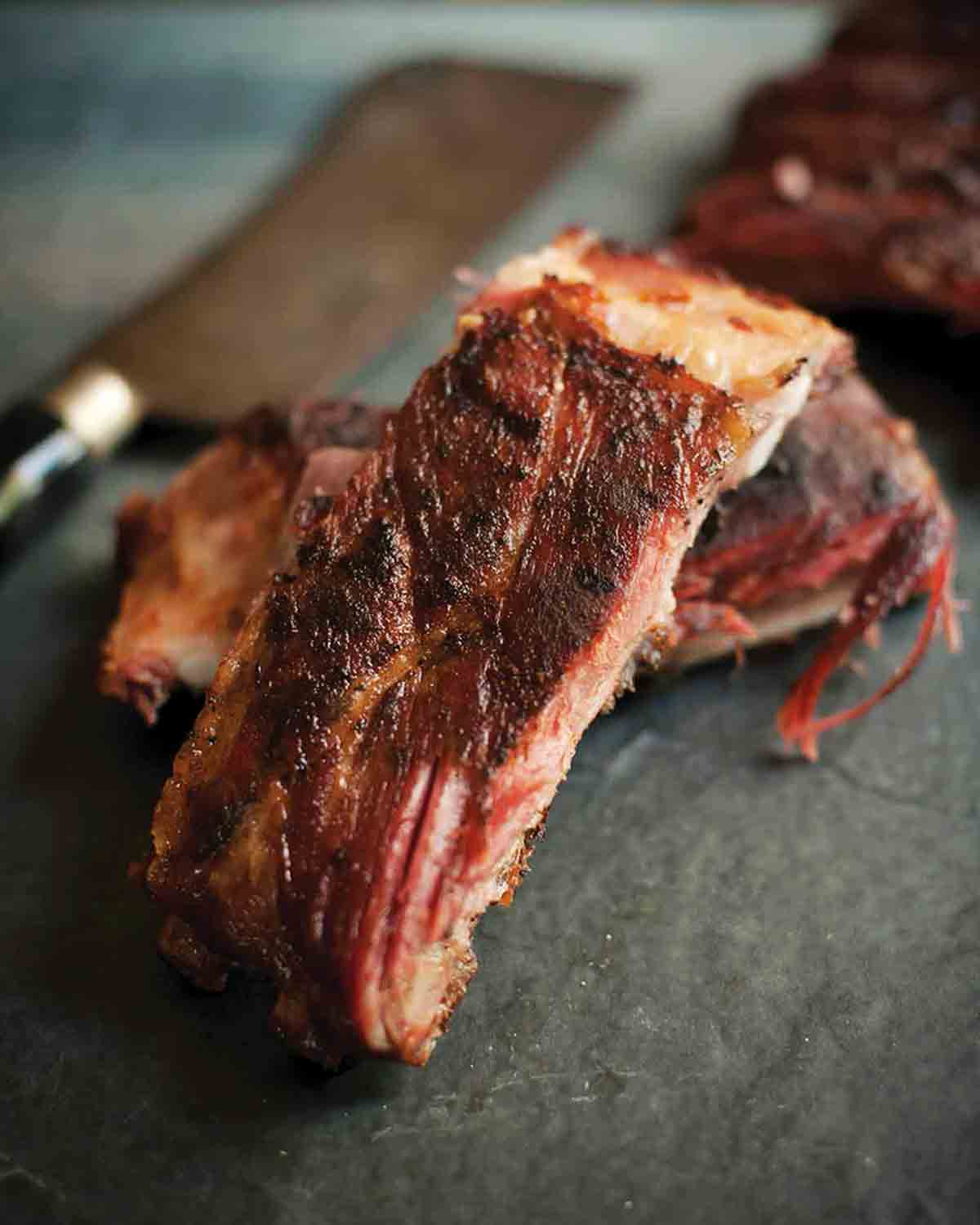
Renee: Here we go. We keep the outdoor grilling theme. We start with smoked spare ribs. You can do them either on the grill or the smoker. They come with a Texas-style barbecue sauce.
David: A little nod to our guest, Mr. Moore.
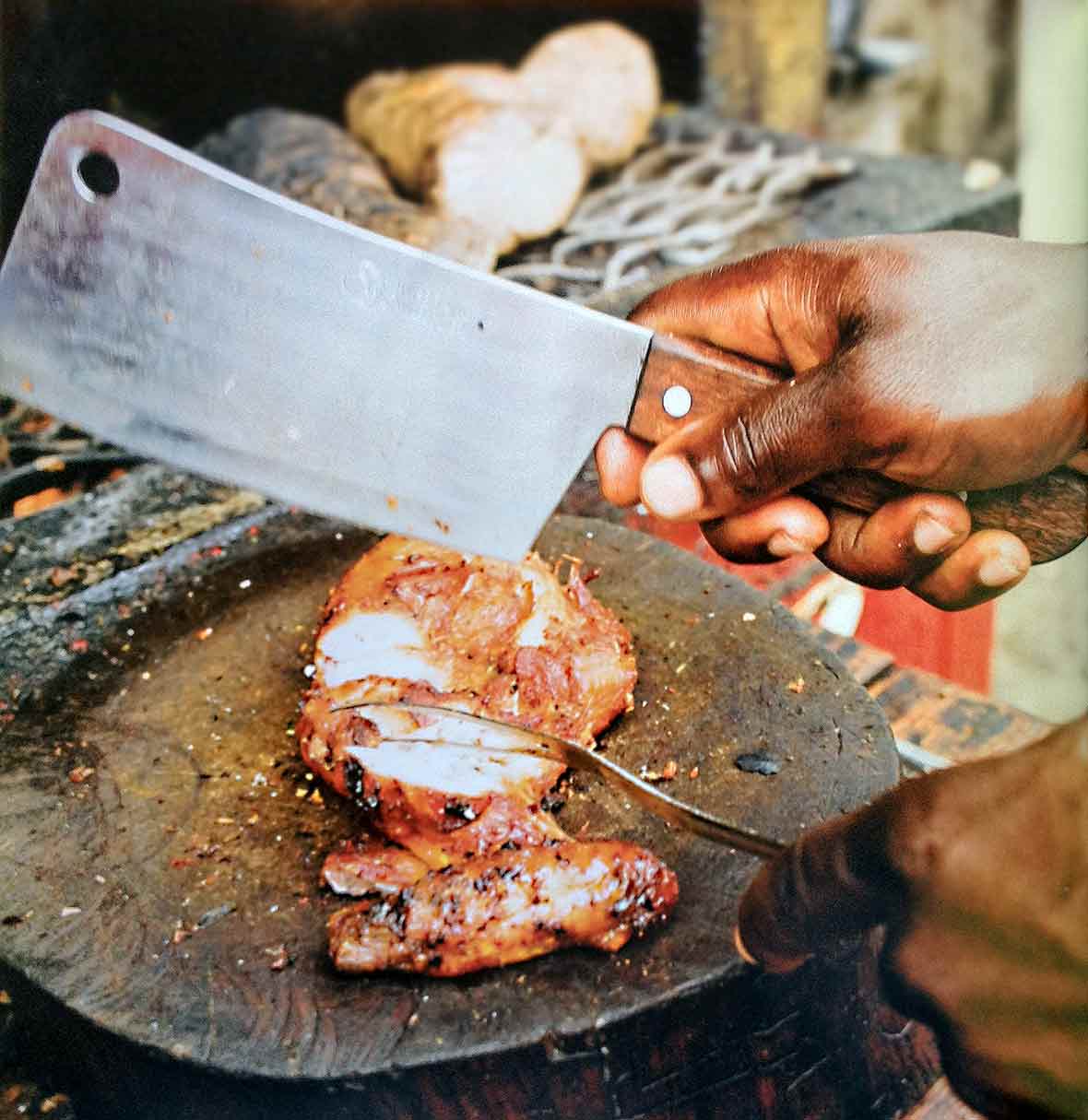
Renee: Yes, absolutely. And we also carry through to Jamaica with some jerk chicken, again, on the grill. We tell you how to make roast potatoes on the grill so you don’t have to do that thing where you’re running in between kitchen and grill when you’re making dinner. Everything comes together in one place. And then we finish it up with a Memphis-style barbecue mop sauce—kind of mustardy, kind of tangy, kind of peppery. Goes on anything. Pork butt, chicken, burgers, you name it.
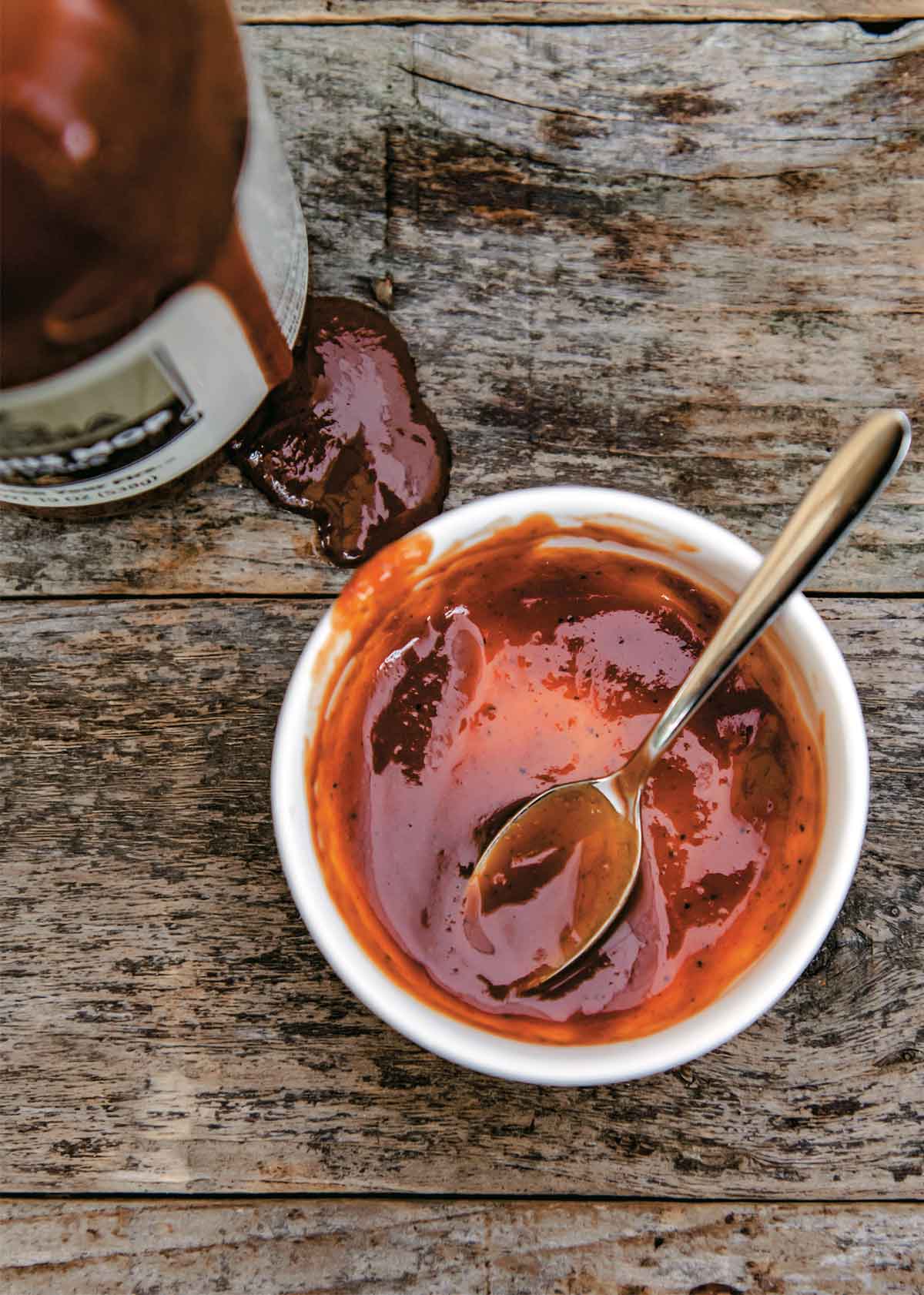
David: Hmmm. I’ve always wanted to get my butt mopped. Thank you very much.
Renee: We are SO not going there!
David: Oh, this podcast is produced by Overit Studios and our producer is the sizzling-hot Adam Clairmont. You can reach Adam and Overit Studios at overitstudios.com. And remember to subscribe to Talking With My Mouth Full wherever you download your favorite podcasts. And if you like what you hear and want to support us, please leave us a review and rating on iTunes. Chow!
Renee: Chow!
